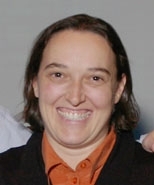Though far from finished with their own work, three senior MIT researchers passed the torch to a new generation of scientists on Tuesday, Nov. 9 at the Museum of Science in Boston.
For the past two years, the museum has named several young New England scientists as the "Next Generation" of revolutionary researchers whose work already has made a significant contribution to their field. This year, the three honorees all work in biotechnology at MIT.
Angelika Amon, the Linda and Howard Stern Career Development Associate Professor of Biology; Chris Burge, Whitehead Career Development Associate Professor in the Department of Biology; and Manolis Kellis, assistant professor in the Department of Electrical Engineering and Computer Science, were all honored. Each honoree gave a presentation of his or her work after being introduced by a senior MIT faculty member--Phillip A. Sharp, Mary Lou Pardu and Eric Lander.
Amon, the 2003 recipient of the National Science Foundation's Waterman Award, is "an emerging star in the field of bioscience," said Institute Professor and Nobel laureate Phillip A. Sharp. "I am sure there will be more awards in her future," he said.
Amon, who thanked Sharp for his words upon taking the podium, shared her work in cell division with the audience of just over 100 people, mostly museum staff and trustees, MIT faculty, and local people in the biotechnology industry.
Amon said she is "obsessed by order," so her work in cell division--where so many small things need to occur with such precision--is only appropriate. "Humans are especially bad at the cell cycle that creates sperm and eggs," said Amon. Ten percent of all human conceptions have an incorrect number of chromosomes, said Amon. This problem can lead to miscarriage and birth defects. "We are hoping we can shed some light on this," she said.
"We want to understand how every single aspect is controlled." Amon's hope is that the work in her lab will "lay the foundation to find cures and drugs for cancer and birth defects in humans," she said.
Mary Lou Pardue, the Boris Magasanik Professor of Biology and internationally known geneticist and cell biologist, introduced Burge. "It has been a delight to watch the younger generation," said Pardue, who expects great things from the bevy of young researchers who have tools she only dreamt of using. "Genomes are available that we never thought would be," said Pardue.
Burge's work in RNA has been revolutionary. Over the past couple of years, Burge and members of his laboratory have learned which specific gene sequences can activate or suppress RNA splicing, and they have developed the first effective models of the human RNA splicing process. Burge said Tuesday night that his ongoing work is focused on the question: "How can we manipulate the splicing of a disordered gene?"
Professor Eric Lander, founding director of the Eli and Edythe L. Broad Institute, whose mission is to create tools for genomic medicine, make them broadly available and use them to propel the understanding and treatment of disease, called it "a good and new experience for me to be part of the old generation." In his introduction of Kellis, Lander said he was impressed with the young scientist's enthusiasm and insights, referring to Kellis as an "extraordinary ball of energy."
Kellis proved Lander's point by speaking enthusiastically about his work. He called it "using evolution to inform genomics, and using genomics to understand evolution." Kellis, who earned his Ph.D. in computer science from MIT, has developed new computational paradigms to help decipher DNA signals, understand gene regulation and clarify the evolutionary mechanisms of genomes. He has applied these tools to the yeast and human genomes, to systematically study all genes and regulatory elements. His work also showed that the yeast genome arose by whole-genome duplication, and that a similar event shaped the early vertabrate evolution of several fish.
Kellis' "never-ending smile and unabashed optimism has always impressed me," Lander said. "This is definitely our future."
A version of this article appeared in MIT Tech Talk on November 17, 2004 (download PDF).








